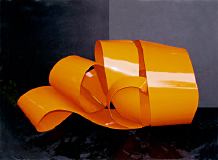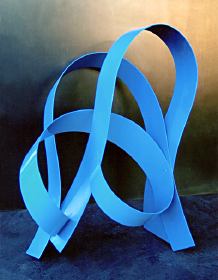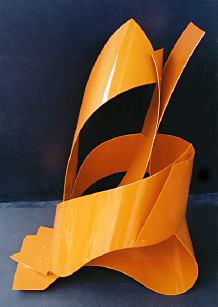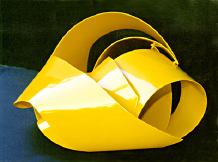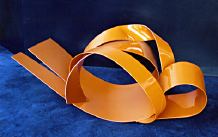
I begin with paper or strips of metal, cutting and folding, making small models to explore
on an intimate scale how form relates to space. I'm influenced by images in the landscape and
how movement changes these images. Rhythms of Greek and Cypriot dances and my study of modern
dance patterns help me to realize how I want to cut through space with my materials and colors.
The seasons, wind, snow, and rushing waterfalls of Norway, the land of my great grandparents,
are also reflected in my work.
The idea of making large scale sculptures began long ago during summer school in Norway. I was
invited to visit Ørnulf Bast, a famous artist, at his studio near Oslo. He had heavy cranes
that pulled and lifted huge blocks of marble into place and emerging from these came remarkable
figures. I found it inspiring but at the time I could not imagine myself working with such massive
forms. The woodcut prints I had seen of Edvard Munch at the National Gallery had already intrigued
me and I felt I would be more comfortable digging into blocks of wood, which I did for some years
to come.
Then, as a student at the University of Wisconsin, Madison, I took a class with Margaret H'Doubler,
the amazing professor who ultimately made modern dance an academic major in many American
institutions. She taught me how to leap, run and and plunge across the gym floor. That was when I
realized what it meant to "cut through space". At the same time, I began to study the book called
JAZZ by the French artist Matisse. With scissors and the bold colors of his painted papers,
he made brilliant cut-outs of dancing shapes. To this day it is one of my favorites and motivates me
in the use of color and motion. It was in London where I saw Anthony Caro's and Phillip King's
sculptures and I had a chance to study their methods of constructing their works in factories.
I had also read about David Smith and I empathized with the geometry of all these artists'
sculptures. After moving to Berkeley, California, I began to make small models that could be
fabricated into large sculptures for public sites. Immediately, I experienced a new sense of freedom
and movement. All those lessons learned in dance, printmaking and painting came into play with each
sculpture. I enjoy the process, the challenge of the materials, aluminum and steel, and the
possibilities that every curve and line suggest in forging a new shape.
Kati Casida was born in Viroqua, a Norwegian farming community in Wisconsin. Her great grandparents
immigrated from Luster, Sognefjord, and Gyland near Flekkefjord. As a child, she lived in the log
cabin her great grandfather had built on his farm when he arrived from Norway. Growing up isolated
on a remote farm, Casida started making drawings in the yard with the use of a stick at the age of
three. With the encouragement of her parents, she developed her talent on the farm and later when her
family moved to La Crosse, WI. She received her B.S. in Art Education at the University of Wisconsin,
Madison, WI. Casida was an Artist-in-Residence at the École Supérieure des Beaux-Arts,
Athenée Hydra, Greece, and at the Edvard Munch Studio in Ekely, Norway. She has also traveled
and studied in many other countries, including Israel, Japan, England, Sweden, Switzerland, Costa Rica,
Peru, Holland, and Germany. In 1964, she and her husband John Casida moved to Berkeley, California.
She founded Nordic 5 Arts, an organization for artists of Nordic heritage in the San Francisco Bay Area,
in 1993.
Kati Casida
e-mail: kefi328@sbcglobal.net
web site: http://katicasida.dreamhosters.com
